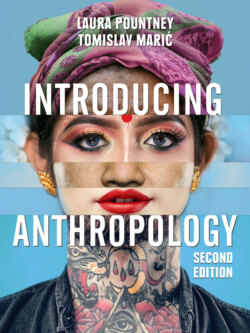Читать книгу Introducing Anthropology - Laura Pountney - Страница 114
Body modification in Western societies
ОглавлениеIn different cultures there are various ideas about what is most important regarding the body; for example, in some cultures adult men must have a beard, while in others they may spend hours plucking every hair from their bodies (for the example of Kayapo culture, see below, pp. 75–7). One common form of body modification in Western society is through cosmetics, which are used to beautify the external body. Some people may believe that a person decorated with make-up is more beautiful than that person in their undecorated state. In Western societies, people spend hundreds of millions of pounds a year on personal hygiene and make-up. In 2019, Fragrance Direct, a leading beauty retailer in the UK, commissioned a survey of one thousand women in the UK to find out exactly how much they were spending on make-up. They discovered that they spend, on average, £482.51 a year on beauty products – which works out at £2.39 per day on the twelve different products they use on their faces. And the actual value of these twelve products at any given time is £113.77. The research also showed that the highest beauty spend is among 16–24-year-olds, who use an average of sixteen beauty products a day, worth £153 in total.
People in Western society spend a considerable portion of their time on their appearance. Ways of conforming to ideas of beauty and attractiveness vary through time and across cultures.
For example, historically defined body shapes and expectations change. At the moment in British and Western fashion, the ideal beautiful body tends to be quite thin, but in the 1950s and early 1960s the ideal female body shape was curvaceous and with ‘good proportions’, meaning measurements of 36:24:36 inches around the bust, waist and hips. Similarly, the amount of bodily hair seen as desirable on men and women has changed dramatically over time.
A popular body modification in Western society for aesthetic reasons is plastic surgery. One example is breast enlargement. As one of the strongest identifiers of a woman’s gender and sexuality, breasts have been the subject of modification for many years. Silicone gel implants were developed in the 1960s, but breast enlargement surgery became more widespread only in the 1980s. Despite the considerable cost and health risks involved, breast enlargement is still the most popular cosmetic procedure performed on British women: more than 30,000 women receive breast implants every year (https://digital.nhs.uk/news-and-events/latest-news/information-about-number-of-breast-implant-surgeries-revealed-in-new-report). According to the International Society of Aesthetic Plastic Surgery, Brazil is the second largest (the USA is the first) consumer of plastic surgery in the world, with 1.2 million surgeries carried out every year. In the section below, Alexander Edmonds explains some of the reasons for these body modifications.
